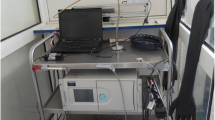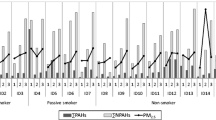Abstract
Considering tobacco smoke as one of the most health-relevant indoor sources, the aim of this work was to further understand its negative impacts on human health. The specific objectives of this work were to evaluate the levels of particulate-bound PAHs in smoking and non-smoking homes and to assess the risks associated with inhalation exposure to these compounds. The developed work concerned the application of the toxicity equivalency factors approach (including the estimation of the lifetime lung cancer risks, WHO) and the methodology established by USEPA (considering three different age categories) to 18 PAHs detected in inhalable (PM10) and fine (PM2.5) particles at two homes. The total concentrations of 18 PAHs (ΣPAHs) was 17.1 and 16.6 ng m−3 in PM10 and PM2.5 at smoking home and 7.60 and 7.16 ng m−3 in PM10 and PM2.5 at non-smoking one. Compounds with five and six rings composed the majority of the particulate PAHs content (i.e., 73 and 78 % of ΣPAHs at the smoking and non-smoking home, respectively). Target carcinogenic risks exceeded USEPA health-based guideline at smoking home for 2 different age categories. Estimated values of lifetime lung cancer risks largely exceeded (68–200 times) the health-based guideline levels at both homes thus demonstrating that long-term exposure to PAHs at the respective levels would eventually cause risk of developing cancer. The high determined values of cancer risks in the absence of smoking were probably caused by contribution of PAHs from outdoor sources.



Similar content being viewed by others
References
Adlkofer F (2001) Lung cancer due to passive smoking—a review. Int Arch Occup Environ Health 74:231–241
Ball A, Truskewycz A (2013) Polyaromatic hydrocarbon exposure: an ecological impact ambiguity. Environ Sci Pollut Res. doi:10.1007/s11356-013-1620-2
Bari A, Baumbach G, Kuch B, Scheffknecht G (2010) Particle-phase concentrations of polycyclic aromatic hydrocarbons in ambient air of rural residential areas in southern Germany. Air Qual Atmos Health 3:103–116
Barnoya J, Glantz SA (2005) Cardiovascular effects of secondhand smoke: nearly as large as smoking. Circulation 111:2684–2698
BéruBé KA, Sexton KJ, Jones TP, Moreno T, Anderson S, Richards RJ (2004) The spatial and temporal variations in PM10 mass from six UK homes. Sci Total Environ 32:41–53
Bhalla DK, Hirata F, Rishi AK, Gairola CG (2009) Cigarette smoke, inflammation, and lung injury: a mechanistic perspective. J Toxicol Environ Health B 2:45–64
Boström CE, Gerde P, Hanberg A, Jernstrom B, Johansson C, Kyrklund T, Rannug A, Tornqvist M, Victorin K, Westerholm R (2002) Cancer risk assessments, indicators, and guidelines for polycyclic aromatic hydrocarbons in the ambient air. Environ Health Perspect 110:451–488
Castro D, Slezakova K, Delerue-Matos C, Alvim-Ferraz M, Morais S, Pereira MC (2011) Polycyclic aromatic hydrocarbons in gas and particulate phases of indoor environment influenced by tobacco smoke: levels, phase distribution and health risks. Atmos Environ 45:1799–1808
Castro D, Slezakova K, Delerue-Matos C, Alvim-Ferraz M, Morais S, Pereira MC (2010) Contribution of traffic and tobacco smoke in the distribution of polycyclic aromatic hydrocarbons on outdoor and indoor PM2.5. Glob Nest J 12:3–11
Castro D, Slezakova K, Delerue-Matos C, Alvim-Ferraz M, Morais S, Pereira MC (2009a) Polycyclic aromatic hydrocarbons in gas and particulate phases of indoor environments influenced by tobacco smoke: levels, phase distributions, and health risks. Atmos Environ 45:1799–1808
Castro D, Slezakova K, Oliva-Teles MT, Delerue-Matos C, Alvim-Ferraz MC, Morais S, Pereira MC (2009b) Analysis of polycyclic aromatic hydrocarbons in atmospheric particulate samples by microwave-assisted extraction and liquid chromatography. J Sep Sci 32:501–510
Cesaroni G, Forastiere F, Agabiti N, Valente P, Zuccaro P, Perucci PA (2008) Effect of the Italian smoking ban on population rates of acute coronary events. Circulation 117:1121–1123
Dacunto P, Cheng K, Acevedo-Bolton V, Jiang R, Klepeis N, Repace J, Ott W, Hildemann L (2013a) Identifying and quantifying secondhand smoke in source and receptor rooms using multiple measures: logistic regression and mass balance approaches, Indoor Air: in press, doi:10.1111/ina.12049
Dacunto P, Cheng K, Acevedo-Bolton V, Klepeis N, Repace J, Ott W, Hildemann L (2013b) Identifying and quantifying secondhand smoke in multiunit homes with tobacco smoke odor complaints. Atmos Environ 71:399–407
Directive 2004/107/EC (2005) Directive of the European Parliament and of the Council relating to arsenic, cadmium, mercury, nickel and polycyclic aromatic hydrocarbons in ambient air. Off J Eur Union L23:3–16
Dransfield MT, Washko GR, Foreman MG, Estepar RSJ, Reilly J, Bailey WC (2007) Gender differences in the severity of CT emphysema in COPD. Chest 132:464–470
Halek F, Nabi G, Kavousi A (2008) Polycyclic aromatic hydrocarbons study and toxic equivalency factor (TEFs) in Tehran, IRAN. Environ Monit Assess 143:303–311
Hoffmann D, Hoffmann I (1997) The changing cigarette, 1950–1995. J Toxicol Environ Health A 50:307–364
International Agency for Research on Cancer (IARC) (2004) Tobacco smoke and involuntary smoking. IARC Monogr Eval Carcinog Risks Hum 83:1–1492
International Agency for Research on Cancer (IARC) (2010) Some non-heterocyclic polycyclic aromatic hydrocarbons and some related exposures. IARC Monogr Eval Carcinog Risks Hum 92:773
International Agency for Research on Cancer (IARC) (2012) Personal habits and indoor combustions: a review of human carcinogens. IARC Monogr Eval Carcinog Risks Hum 100E:213–263
International Standard ISO 16000–1:2004 (2004) Indoor air Part 1: general aspects of sampling strategy. International Organization for Standardization, Geneva, Switzerland
King B, Babb S, Tynan M, Gerzoff R (2013) National and state estimates of secondhand smoke infiltration among U.S. multiunit housing residents. Nicotine Tob Res 15:1316–1321
Klepeis N, Apte M, Gundel L, Sextro R, Nazarof W (2003) Determining size-specific emission factors for environmental tobacco smoke particles. Aerosol Sci Technol 37:780–790
Liu Y, Zhu L, Shen X (2001) Polycyclic aromatic hydrocarbons (PAHs) in indoor and outdoor air of Hangzhou, China. Environ Sci Technol 35:840–844
Lu H, Chen S (2008) Pollution level, phase distribution and health risk of polycyclic aromatic hydrocarbons in indoor air at public places of Hangzhou, China. Environ Pollut 152:569–575
Madureira J, Mendes A, Almeida S, Teixeira JP (2012) Positive impact of the Portuguese smoking law on respiratory health of restaurant workers. J Toxicol Environ Health A 75:776–787
McNabola A, Gill LW (2009) The control of environmental tobacco smoke: a policy review. Int J Environ Res Publ Health 6:741–758
Mugica V, Hernandez S, Torres M, García R (2010) Seasonal variation of polycyclic aromatic hydrocarbon exposure levels in Mexico City. J Air Waste Manag Assoc 60:548–555
Muller P (1997) Scientific criteria document for multimedia standards development polycyclic aromatic hydrocarbons (PAH); part 1: hazard identification and dose–response assessment. Ministry of Environment and Energy, Ontario, Canada
Nisbet ITK, LaGoy PK (1992) Toxic equivalency factors (TEFs) for polycyclic aromatic hydrocarbons (PAHs). Regul Toxicol Pharmacol 16:290–300
Ohura T, Amagai T, Sugiyama T, Fusaya M, Matsushita H (2004) Characteristics of particle matter and associated polycyclic aromatic hydrocarbons in indoor and outdoor air in two cities in Shizuoka, Japan. Atmos Environ 38:2045–2054
Okona-Mensah KW, Battershill J, Boobis A, Fielder R (2005) An approach to investigating the importance of high potency polycyclic aromatic hydrocarbons (PAHs) in the induction of lung cancer by air pollution. Food Chem Toxicol 43:103–116
Pacheco SA, Aguiar F, Ruivo P, Proença MC, Sekera M, Penque D, Simões T (2012) Occupational exposure to environmental tobacco smoke: a study in Lisbon restaurants. J Toxicol Environ Health A 75:857–866
Pope CA 3rd, Burnett RT, Thun MJ, Calle EE, Krewski D, Ito K, Thurston GD (2002) Lung cancer, cardiopulmonary mortality, and long-term exposure to fine particulate air pollution. JAMA 287:1132–1141
Pufulete M, Battershill J, Boobis A, Fielder R (2004) Approaches to carcinogenic risk assessment for polycyclic aromatic hydrocarbon: a UK perspective. Regul Toxicol Pharmacol 40:54–56
Ramalhosa MJ, Paíga P, Sousa AMM, Gonçalves MP, Morais S, Delerue-Matos C, Prior Pinto Oliveira MB (2012) Analysis of polycyclic aromatic hydrocarbons in fish: optimization and validation of microwave-assisted extraction. Food Chem 135:232–242
Raupach T, Schafer K, Konstantinides S, Andreas S (2008) Second-hand smoke as an acute threat for the cardiovascular system: a change in paradigm. Eur Heart J 27:386–392
Rodgman A, Perfetti AT (2008) The chemical components of tobacco and tobacco smoke. CRC, Boca Raton, USA
Slezakova K, Castro D, Delerue-Matos C, Alvim-Ferraz MC, Morais S, Pereira MC (2011) Air pollution from traffic emissions in Oporto, Portugal: Health and environmental implications. Microchem J 99:51–59
Slezakova K, Castro D, Pereira MC, Morais S, Delerue-Matos C, Alvim-Ferraz MC (2009) Influence of tobacco smoke on the elemental composition of indoor particles of different sizes. Atmos Environ 43:486–493
Slezakova K, Castro D, Pereira MC, Morais S, Delerue-Matos C, Alvim-Ferraz MC (2010) Influence of traffic emissions on the carcinogenic polycyclic aromatic hydrocarbons in outdoor breathable particles. J Air Waste Manag Assoc 60:393–401
Slezakova K, Pires JCM, Castro D, Alvim-Ferraz MC, Delerue-Matos C, Morais S, Pereira MC (2013) PAH air pollution at a Portuguese urban area: carcinogenic risks and sources identification. Environ Sci Pollut Res 20:3932–394
Thielen A, Klus H, Muller L (2008) Tobacco smoke: unraveling a controversial subject. Exp Toxicol Pathol 60:141–156
United States Environmental Protection Agency (USEPA) (1989) Risk assessment guidance for superfund, vol. I: human health evaluation manual. EPA/540/1–89/002. Office of Emergency and Remedial Response, Washington DC, USA
United States Environmental Protection Agency (USEPA) (1993) EPA designates passive smoking a “Class 1” or known human carcinogen. <http://www.epa.gov/history/topics/smoke/01.html>, Accessed 26 February 2013
United States Environmental Protection Agency (USEPA) (2008) Child-specific exposure factors handbook (Final report) 2008. EPA/600/R-06/096F. National Centre for Environmental Assessment Office of Research and Development, Washington DC, USA
United States Environmental Protection Agency (USEPA) (2013) Risk-based Concentration Table. <http://www.epa.gov/reg3hwmd/risk/human/rb-concentration_table/usersguide.htm>, Accessed in November 2013
Vieira C, Morais S, Ramos S, Delerue-Matos C, Oliveira MBPP (2011) Mercury, cadmium, lead and arsenic levels in three pelagic fish species from the Atlantic Ocean: Intra- and inter-specific variability and human health risks for consumption. Food Chem Toxicol 49:923–932
Wallace LA, Mitchell H, O’Connor GT, Neas L, Lippmann M, Kattan M, Koenig J, Stout JW, Vaughn BJ, Wallace D, Walter M, Adams K, Liu LJS (2003) Particle concentrations in inner-city homes of children with asthma: the effect of smoking, cooking, and outdoor pollution. Environ Health Perspect 111:1265–1272
World Health Organization (WHO) (1987) Air quality guidelines for Europe. WHO Regional Office for Europe, Copenhagen, Denmark
World Health Organization (WHO) (1998) Environmental health criteria 202: Selected non-heterocyclic polycyclic aromatic hydrocarbons. World Health Organization, Geneva, Switzerland, Accessed 20 December 2012, <http://www.inchem.org/documents/ehc/ehc/ehc202.htm#SectionNumber:1.3>
World Health Organization (WHO) (2000) Air quality guidelines for Europe—second edition. WHO Regional Office for Europe, Copenhagen, Denmark
World Health Organization (WHO) (2006) Air quality guidelines, global update 2005. WHO Regional Office for Europe, Copenhagen, Denmark
World Health Organization (WHO) (2009) WHO report on the global tobacco epidemic 2009: implementing tobacco smoke-free environments. World Health Organization, Geneva, Switzerland
Acknowledgments
This work was supported by Fundação para Ciência e Tecnologia through grants number PEst-C/EQB/LA0006/2011 and PEst-C/EQB/UI0511/2011, and fellowship SFRH/BPD/65722/2009.
Author information
Authors and Affiliations
Corresponding author
Additional information
Responsible editor: Gerhard Lammel
Electronic supplementary material
Below is the link to the electronic supplementary material.
ESM 1
(DOCX 18 kb)
Rights and permissions
About this article
Cite this article
Slezakova, K., Castro, D., Delerue-Matos, C. et al. Levels and risks of particulate-bound PAHs in indoor air influenced by tobacco smoke: a field measurement. Environ Sci Pollut Res 21, 4492–4501 (2014). https://doi.org/10.1007/s11356-013-2391-5
Received:
Accepted:
Published:
Issue Date:
DOI: https://doi.org/10.1007/s11356-013-2391-5




